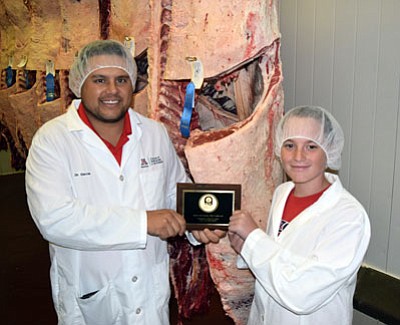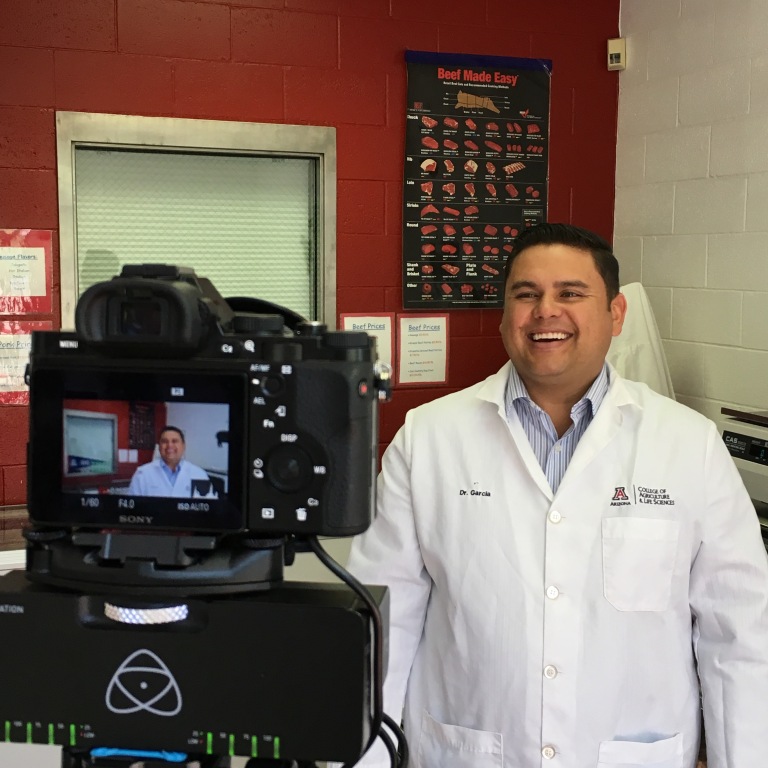Ranchers: My dad, Ruben Garcia, and I, Samuel Ruben Garcia, ranch on the Rancho La Playa, Rancho El Fresno, and Rancho Santa Gertrudis. My uncle Ramiro Garcia ranches on the Rancho La Higuerita and my uncle Sergio Garcia is on the Rancho El Alamo Rancho El Henry. All of the ranches are in Sonora, Mexico about 40 miles south of Douglas, Arizona. My wife Christina and I, with our son RJ and daughter Celeste, live and work in Tucson, Arizona.
Tell us a little bit about yourself, your family and about your ranch and what you do now:
I grew up around cattle ranching and it has been a lifelong passion of mine. A majority of my time has been spent working with my family on various ranches. When I was growing up, ranching was a tough business, but I stayed true to what I enjoyed and pursued a career that kept me close to my passion. Growing up in Mexico was great, but there was a limit to the amount of education I could receive and my dad decided it was a good step for me to learn English and further my education in the United States.
At age 11, I moved out of my home and made a new home with Alfonso and Teresita Gonzales, who were working for the Dobson Cattle Company in Benson, Arizona. They took me in as if I was their son and added an abundant amount of knowledge about cattle and horses by doing the many chores expected of a ranch kid. After three years, I moved back to Douglas, Arizona where I finished high school.
After high school graduation, I attended two years at Cochise College and finally decided to transfer to the University of Arizona (UA) where I received a Bachelor in Veterinary Science in 2008. I then spent a year at the ranch with my dad to reenergize before venturing back to the UA to complete a Master’s in Animal Sciences in 2011 and a Ph.D. in 2013. After graduation, I took a job as a Lecturer in the School of Animal and Comparative Biomedical Sciences. In 2014, I started as the manager of the Food Products and Safety Lab, which includes an animal harvesting facility, where I am now. I still continue to ranch with my father.
My grandfather was an accountant-turned-businessman-turned-rancher. He was a cattle buyer for many years and was able to purchase most of the ranches owned now by my family.
The ranches are desert ranches. Many improvements have been done to make them successful. Infrastructure that includes water distribution and storage, cattle working facilities and fencing have been our focus.
How did your ranching background get you to where you are today?
From ranching, I learned hard work and dedication, which have been most relevant to my career. You should never give up on your goals but remain flexible in how you accomplish them.

What are some common misconceptions that you think people may have about the way your raise your beef on your ranch and what happens in a harvesting facility?
One important thing to note is that most citizens in Mexico are still one generation away from the farm and ranch, so they know the reality of how food is raised. I’ve noticed people in the US, who are, on average, three generations away from a farm or ranch, are removed from how food is grown and raised.
There is also a misconception about the quality of Mexican cattle. The reality is that cattle raised in Mexico can be quite competitive with cattle raised in the US and are held to high standards while experiencing many health checks before entering the US market.
As to the Food Product and Safety Lab which houses the UA’s harvesting facility, we strive to be transparent in all we do. We serve as an educational facility for both students and Arizona ranchers while also providing meat for the community and harvesting services to Arizona farmers and ranchers.
What is the most important thing that you do on your ranch and in the harvesting facility every day to make sure you are raising and preparing safe beef for consumers?
At the University of Arizona Food Product and Safety Lab, we ensure that all strict USDA regulations are followed. Protocols are in place to ensure the meat produced is safe and wholesome for my family and the consumer’s family to eat!
At the ranch, we make sure health and nutrition of the animals are the number one priority. With healthy animals, everything else falls into place.
What is the most important piece of information that you want people to know about you and the work you do on you ranch and in the harvesting plant every day?
I want to emphasize that the meat produced in the US is the safest in the world. Also, Sonoran ranchers who export cattle into the US are contributing to this wholesome food supply.

If you could describe in one word the life of a rancher, what would it be?
Sensational
Lastly, and of course most importantly, what is your favorite cut of beef and how do you like to prepare it?
Aged Ribeye grilled on mesquite with sea salt/coarse salt. Medium Rare.












2 thoughts on “Meet Your Rancher: Dr. Sam Garcia and Family”